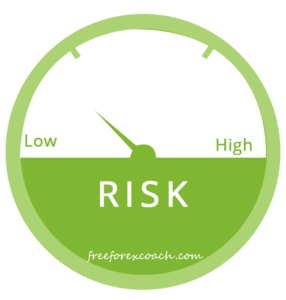With these Forex risk management tools, you are able to reduce on the level of risk in the market since it cannot be avoided.
Profits difference comes on how you determine the risk and manage your risks in order to stay profitable on a long term basis
Is risk management important to a Forex trader? YES, more than you can imagine!
Risk management is one of the most important topics that every trader should not take lightly or skip in their learning journey.
For every business to successfully operate, we must expect some risks along the way in one way or the other.
But you cannot sit and wait till such risks happen and then think of how to deal with them.
It may be too late and may cause a great damage. That’s why we need a plan on how to manage those risks or insure them to cover the damage.
So to profit from Forex, you must be willing to risk. I mean the way to make money in Forex trading is to risk.
So, let’s study some forex risk management tools to keep us profitable!
The 6 Risk Management tools you must have on your Trading plan
- Stop loss and targets levels
- Risk – reward ratio
- position size
- Risk per trade
- Trading rules
- Leverage and margin
Let us now learn these forex risk management tools in details;
1. Stop loss and target levels
Stop loss order is one of the most effective risk management tool in Forex trading.
It is the price level at which your order closes out when you are wrong about the market direction. This is the maximum loss you can take when a trade goes wrong.
Knowing the point in advance at which you want to exit a position means you can prevent large losses.
On the other hand, setting a target level, you predict how far price will move before making a retracement or a pull back to your stop loss.
You should aim at having a target that is realistic and attainable. Your targets for trades should be enough in that even if you have consecutive losses, you can still stay in profit
2. Risk – Reward ratio
Risk to reward ratio, compares your stop loss level and your target profit level for your trades.
It is the amount of profit you plan to get on a trade relative to what you are risking in case of a loss.
Normally, we measure the distance from your entry level point opposite your predicted direction for the stop loss.
Also measure the distance from your entry level to your predicted direction for the target profit. Then compare the two. Your target point should be at least twice the stop loss.
The bigger the possible rewards, the more failed trades your account can withstand at a time.
For example,
If you have 1:3 risk – reward ratio, one successful trade will sustain you through 3 consecutive bad trades with the same ratio. Your account will still have a profit.
3. Risk per trade
Risk per trade is the amount of money you are willing to put on each trade you take.
It should always be a small percentage of your total capital.
Most experience traders use a rule of 2% of deposit, risk per trade. Preferably 1 -3% risk can sustain you in the Forex market
For example,
If you have $5000 in your account, and you choose to risk 2% of your account.
This means your maximum loss would be $100 per trade.
A 2% loss per trade would mean you have 50 chances to lose before you wipe out your account.
However, if you don’t know how much you are willing to lose, you may end up using large position sizes, resulting to large losses.
As a result, you may not afford to take on the next trade or lose your account.
4. Position size
To position size is to determine how many units you should trade to achieve the desired level of risk. First, you must know how much you are willing to risk on each trade you take.
Position sizing in Forex trading determines how many units of money/ lots you trade in each position you take. It can be a micro-lot, min or standard.
This one of the forex risk management tools you must master!
To determine your position size, you need to know your stop in pips, determine your risk per trade and lot size. we shall discuss more when we get to position sizing as a topic.
5. Leverage and Margin
Forex brokers provide traders with the opportunity to trade with more money than the balance of their accounts, Leverage.
A margin is an amount of money you need to have on your account in order to open a trade on a bigger amount you have on balance.
Leverage is a double-edged sword. It increases both your gains and losses.
With a $1,000 on your account, you can hold a trade worth $100,000.
This is a 100:1 leverage. This shows that your account increases 100 times the initial.
A one pip loss in a 100:1 leverage is equal to $10. So if you had 10 mini lots in the trade, and you lost 50 pips, your loss would be $500, not $50.
To use leverage you must always have a stop loss in place and use a small position to prevent large draw downs.
6. Trading rules
Your trading rules are very important when it’s time to trade.
Trading rules tell you what to do and not to do. How to do it, when and what to do. Your trading rules is Your trading plan.
If you follow your rules, you will know how to adjust to unexpected conditions in case they happen in the market. Also how and when to cut your losses.
Having a plan will help you to control your emotions, avoid making decisions in a panic and trade objectively.
In conclusion
Forex market is highly unpredictable. Anything can happen in the market at any point. Just small news can make the markets go volatile within just seconds.
And this may cause a big loss from your account if you hadn’t managed your account well. So you have to always be ready.
However much you are risking the money you can afford to lose, you should have measures to protect your account from large losses
Don’t trade like you are in a casino gambling house. Forex is not a game for the gamblers. You need some rules, money management and a trading plan to trade Forex and profit from it.
It doesn’t matter how skilled you are or how perfect your system is? Without risk management you can still blow your account.
Have risk management rules well stated on your trading plan and develop a habit of following your trading plan always, every time you enter a trade.
This is the only way to protect your capital and make consistent profits in the market.
How Does Greed Impact your Forex Trading Success?
There are several ways greed can impact your Forex trading success. Firstly, greed can make you abandon your well crafted trading strategy in favor of impulsive and speculative actions. Instead of adhering to predetermined entry and exit points based on technical or...
-
- Topic
- Voices
- Last Post




